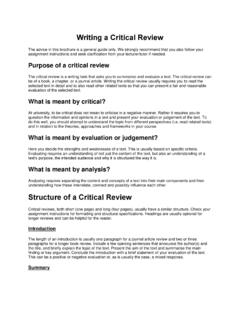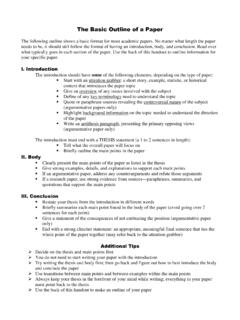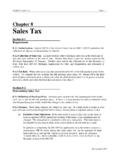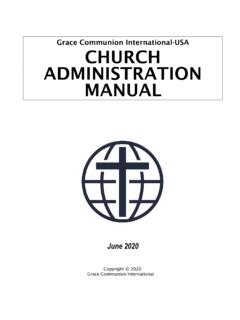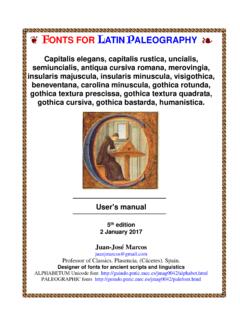Transcription of MLA In-Text Citations: The Basics
1 MLA In-Text Citations: The Basics Guidelines for referring to the works of others in your text using MLA style are covered in chapter 6 of the MLA Handbook and in chapter 7 of the MLA Style Manual. Both books provide extensive examples, so it's a good idea to consult them if you want to become even more familiar with MLA guidelines or if you have a particular reference question. Basic In-Text citation rules In MLA style, referring to the works of others in your text is done by using what is known as parenthetical citation.
2 This method involves placing relevant source information in parentheses after a quote or a paraphrase. General Guidelines The source information required in a parenthetical citation depends (1.) upon the source medium ( Print, Web, DVD) and (2.) upon the source s entry on the Works Cited (bibliography) page. Any source information that you provide In-Text must correspond to the source information on the Works Cited page. More specifically, whatever signal word or phrase you provide to your readers in the text, must be the first thing that appears on the left-hand margin of the corresponding entry in the Works Cited List.
3 In-Text citations: Author-page style MLA format follows the author-page method of In-Text citation. This means that the author's last name and the page number(s) from which the quotation or paraphrase is taken must appear in the text, and a complete reference should appear on your Works Cited page. The author's name may appear either in the sentence itself or in parentheses following the quotation or paraphrase, but the page number(s) should always appear in the parentheses, not in the text of your sentence.
4 For example: Wordsworth stated that Romantic poetry was marked by a "spontaneous overflow of powerful feelings" (263). Romantic poetry is characterized by the "spontaneous overflow of powerful feelings" (Wordsworth 263). Wordsworth extensively explored the role of emotion in the creative process (263). Both citations in the examples above, (263) and (Wordsworth 263), tell readers that the information in the sentence can be located on page 263 of a work by an author named Wordsworth. If readers want more information about this source, they can turn to the Works Cited page, where, under the name of Wordsworth, they would find the following information: Wordsworth, William.
5 Lyrical Ballads. London: Oxford UP, 1967. Print. In-Text citations for print sources with known author For Print sources like books, magazines, scholarly journal articles, and newspapers, provide a signal word or phrase (usually the author s last name) and a page number. If you provide the signal word/phrase in the sentence, you do not need to include it in the parenthetical citation. Human beings have been described by Kenneth Burke as "symbol-using animals" (3). Human beings have been described as "symbol-using animals" (Burke 3).
6 These examples must correspond to an entry that begins with Burke, which will be the first thing that appears on the left-hand margin of an entry in the Works Cited: Burke, Kenneth. Language as Symbolic Action: Essays on Life, Literature, and Method. Berkeley: U of California P, 1966. Print. In-Text citations for print sources by a corporate author When a source has a corporate author, it is acceptable to use the name of the corporation followed by the page number for the In-Text citation. You should also use abbreviations ( , nat'l for national) where appropriate, so as to avoid interrupting the flow of reading with overly long parenthetical citations.
7 In-Text citations for print sources with no known author When a source has no known author, use a shortened title of the work instead of an author name. Place the title in quotation marks if it's a short work (such as an article) or italicize it if it's a longer work ( plays, books, television shows, entire Web sites) and provide a page number. We see so many global warming hotspots in North America likely because this region has "more readily accessible climatic data and more comprehensive programs to monitor and study environmental change.
8 " ("Impact of Global Warming" 6). In this example, since the reader does not know the author of the article, an abbreviated title of the article appears in the parenthetical citation which corresponds to the full name of the article which appears first at the left-hand margin of its respective entry in the Works Cited. Thus, the writer includes the title in quotation marks as the signal phrase in the parenthetical citation in order to lead the reader directly to the source on the Works Cited page. The Works Cited entry appears as follows: "The Impact of Global Warming in North America.
9 " Global Warming: Early Signs. 1999. Web. 23 Mar. 2009. We'll learn how to make a Works Cited page in a bit, but right now it's important to know that parenthetical citations and Works Cited pages allow readers to know which sources you consulted in writing your essay, so that they can either verify your interpretation of the sources or use them in their own scholarly work. Author-page citation for classic and literary works with multiple editions Page numbers are always required, but additional citation information can help literary scholars, who may have a different edition of a classic work like Marx and Engels's The Communist Manifesto.
10 In such cases, give the page number of your edition (making sure the edition is listed in your Works Cited page, of course) followed by a semicolon, and then the appropriate abbreviations for volume (vol.), book (bk.), part (pt.), chapter (ch.), section (sec.), or paragraph (par.). For example: Marx and Engels described human history as marked by class struggles (79; ch. 1). Citing authors with same last names Sometimes more information is necessary to identify the source from which a quotation is taken.
